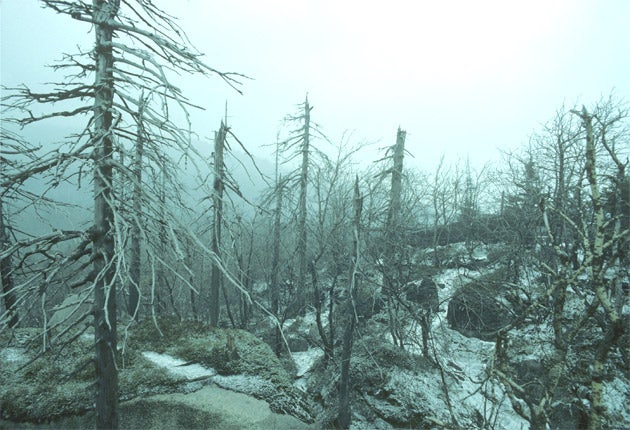Car fumes raise spectre of 1980s revival nobody wants...acid rain

Thirty years ago it was one of the great environmental issues, along with the hole in the ozone layer and CFC chemicals. Now acid rain may be making a comeback – but this time, there's a change in the chemicals responsible.
Nitrogen emissions from motor vehicles and agricultural fertilisers, are combining with rain to produce nitric acid, and are starting to replace the sulphuric acid resulting from power-station emissions as a major source of the environmental scourge of the 1970s and 1980s, according to American experts.
The result is a renewed and serious environmental risk for forests, rivers and wildlife, as nitric acid rain can – just like its sulphuric equivalent – kill plants, fish and insects by leaching important plant nutrients such potassium, calcium and magnesium from the soil. At the same time, it can help to liberate potentially toxic minerals such as aluminium, which can flow off into watercourses. The concern is surfacing in the US, where several scientists have voiced their worries in the current issue of the journal Scientific American.
But the problem exists in Britain and Europe too, especially in Scandinavia, which, because of prevailing westerly winds, receives much of the UK's air pollution. "The issue hasn't gone away," said Ed Dearnley, policy officer for air quality at the charity Environmental Protection UK.
In fact, many EU member states are not on course to meet new limits on nitrogen air pollution which come into force at the end of this year, under the 1999 Gothenburg Protocol, which attempts to do for air pollution what the 1997 Kyoto Protocol attempted to do for climate change: solve the problem by reducing emissions.
The UK is unlikely to meet its limits for NOx (oxides of nitrogen) under the EU National Emission Ceilings Directive, although by a smaller margin than many other countries. Britain expects to overshoot its NOx ceilings by less than 5 per cent, whereas France and Spain look like exceeding theirs by about 30 per cent.
In the US, although nitrogen pollution has been reduced, it has not gone down as much as sulphur pollution. Sulphur dioxide emissions decreased by almost 70 per cent from 1990 to 2008, but emissions of NOx went down only 35 per cent during the same period. Scientists "have grown increasingly aware of the consequences of the remaining nitric acid deposition", according to Professor William Schlesinger, president of the Cary Institute for Ecosystem Studies in Millbrook, New York.
Professor Schlesinger said it is clear that humans are adding nitrogen to the Earth's surface, and although researchers do not know yet where it all goes, "we do know that increasing concentrations of nitrogen in unexpected places will cause significant environmental damage that we will all learn to regret".
According to Scientific American, the Professor thinks that national arguments over climate change have allowed the US to ignore the nitrogen problem, which he predicts will be the next big environmental issue.
Atmospheric nitrogen is not only responsible for acid rain; when it falls to earth it also causes eutrophication, an excess of nutrients which can lead to algal blooms on lakes and can disrupt plant diversity by letting a very few plant species outcompete almost everything else.
Subscribe to Independent Premium to bookmark this article
Want to bookmark your favourite articles and stories to read or reference later? Start your Independent Premium subscription today.

Join our commenting forum
Join thought-provoking conversations, follow other Independent readers and see their replies